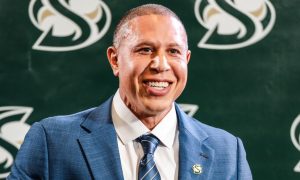|
|
|
ARIZONA PRODUCTIVITY RATING
[table “” not found /]
GLOSSARY:
G: Games played. S: Number of starts.
BP: Bench points. A player gets three points if he is first off the bench, two if second and one if third. Shows Sean Miller’s rotation.
CAL: Productivity points against Cal
CMIN: Minutes played against Cal
PP: Productivity Points (Points, assists, rebounds, steals, blocked shots, FGs made, FTs made added together and then subtracted by missed FGs, missed FTs, personal fouls and turnovers)
TMIN: Minutes played overall
PR: Productivity rating per minute played (Productivity points divided by minutes played)
NOTE: Player must average at least 10 minutes a game to be listed in primary rotation
|
[table “” not found /] |
Arizona’s season is unlike any other, which is appropriate because college basketball and the Pac-12 are not what your parents followed. The Wildcats lost their third game of the season Sunday in Cal’s 77-69 victory at McKale Center. Arizona lost its third game last season on Dec. 7 at Florida. With many struggles — late-game rallies, early-game woes and mid-game adjustments with three freshmen playing extensively — it feels like Arizona (20-3 overall, 8-3 in the Pac-12) should have lost its third game two months ago. Arizona’s demise against Cal was symbolic of the nation’s highly ranked teams taking a tumble. It marked the sixth time in the past week that a team ranked in the Associated Press’ top seven has lost to an unranked team: Tuesday: Arkansas 80, No. 2 Florida 69 Arizona was the lone team out of this group to lose at home. Solomon Hill told the media after the game that losing home games to UCLA and Cal “are games that are going to come back to bite us.” |
“I don’t think any teams expect to sweep on the road, so the most important thing is to win at home,” Hill said. “This next road trip (to Colorado and Utah) is something that’s going to be big for us because we expect more out of ourselves defensively.
“Colorado and Utah especially are defensive minded teams and are going to make you play their game. We have to watch a lot of film to prepare for it and be ready for it instead of just saying it. Once guys like Allen (Crabbe) get going, it’s something you have to jump on early and stop and we didn’t do that tonight.”
Crabbe not only got going, he was like a thoroughbred at full throttle. In this site’s productivity rating system, Crabbe achieved the conference’s highest total of the season: 50 productivity points in 36 minutes. It equaled the 50 productivity points ASU’s Jordan Bachynski had against UCLA on Jan. 26.
Crabbe scored 31 points, making 12 of 15 field-goal attempts, including 4 of 7 from three-point range. He also was 3 of 4 from the free-throw line, and had seven rebounds and five assists to go with only two turnovers.
His performance has Cal believing it is good enough to make the NCAA tournament with a 14-9 overall record with four weeks left in the regular season. The Golden Bears, who upset then-No. 10 Oregon last week, are only two games back in the loss column in the Pac-12 standings to leaders Oregon, UCLA and Arizona.
Eight teams have winning conference records with a month remaining until the Pac-12 tournament. That’s unheard of at this stage. USC, with an 11-13 overall record and playing for interim coach Bob Cantu, has won three consecutive games and is tied with Cal, Stanford and Colorado with a 6-5 conference record. The Trojans travel to the Bay area this weekend.
“We’re playing with no leash,” USC junior guard J.T. Terrell told the Los Angeles Times.
Parity has USC, of all teams, believing in life after the regular season. College basketball is becoming a level playing field because of early departures to the NBA and a heavier reliance on younger talent that feels entitled to playing time after gaining popularity in the AAU tournaments. Kentucky coach John Calipari is finally feeling the strain with that, living on the NCAA tournament bubble playing in the weak SEC with a 17-6 overall record.
Arizona starts freshman center Kaleb Tarczewski and power forward Brandon Ashley, and freshman forward Grant Jerrett is averaging 18.4 minutes a game.
The Wildcats have started two true freshmen a few times before under Lute Olson and Sean Miller, but the coaches have rarely played three true freshmen extensively like this season.
Olson started three freshmen in 1998-99: Ruben Douglas, shooting guard, and forwards Richard Jefferson and Michael Wright. The Wildcats finished 22-7 overall and second in the Pac-10 with a 13-5 record. Luke Walton averaged 25.5 minutes a game as a redshirt freshman reserve in 1999-2000 with true freshmen Jason Gardner and Gilbert Arenas starting in the backcourt. The Wildcats finished 27-7 and won the Pac-10 title with a 15-3 record that season.
Moreover, Olson and Miller never before started two freshman post players such as Tarczewski and Ashley. They have started at least one freshman guard or wing player who possess more immediately fluidity in the offensive framework. Miller has started two freshmen in three of his first four years in Tucson.
These are the seasons in which two or more freshmen started in the Olson and Miller eras at Arizona:
- 1985-86: Sean Elliott, small forward, and Anthony Cook, power forward
- 1998-99: Ruben Douglas, shooting guard; Richard Jefferson, small forward; and Michael Wright, power forward
- 1999-00: Jason Gardner, point guard, and Gilbert Arenas, shooting guard
- 2001-02: Salim Stoudamire, shooting guard, and Channing Frye, center
- 2009-10: Solomon Hill, small forward, and Derrick Williams, power forward
- 2011-12: Josiah Turner, point guard, and Nick Johnson, shooting guard
- 2012-13: Brandon Ashley, power forward, and Kaleb Tarczewski, center
Despite the player turnover, and the infusion of new, raw talent, Miller has coached the Wildcats to a 20-3 record. Arizona is still the most balanced team in the conference in terms of productivity from the Nos. 1 to 7 players in the rotation. Despite the loss to Cal on Sunday, the Wildcats are one of 15 to 20 teams with a realistic shot to make a deep run in the NCAA tournament.
“There aren’t one or two teams that are head and shoulders above everybody else,” Florida coach Billy Donovan told the USA Today. “You can go and take everybody’s best game they’ve played and say, ‘Boy, that team’s unbeatable.’ Not everybody sustains that level night in and night out. There’s a dropoff. … There are a lot of teams that have displayed the potential to really, really, really play at a high level. Can they consistently?”
An alarming trend of late: The Wildcats have been out-rebounded in three of their last six games after out-rebounding opponents in 14 of their first 17 games. Cal won the battle of the boards 31-28.
Defensive Rebounding Percentage (DRB%): Determined by dividing Arizona’s defensive rebounds (17 against Cal) by the opposition’s offensive rebounds (Cal had only five because it shot 58.8 percent from the field) added to Arizona’s defensive rebounds (17) — 17/(5 + 17) = 77.3 percent.
Offensive Rebounding Percentage (ORB%): Determined by taking Arizona’s offensive rebound total (11) divided by that total (11) and the defensive rebounds of the opponent (26 for Stanford) — 11/(11 + 26) = 29.8 percent.
Ideal marks are 72 percent DRB% and 38 percent ORB%.
|
DEFENSIVE/OFFENSIVE REBOUNDING% [table “” not found /] |
Site publisher, writer and editor Javier Morales is a former Arizona Press Club award winner
[rps-paypal]
|
|






























